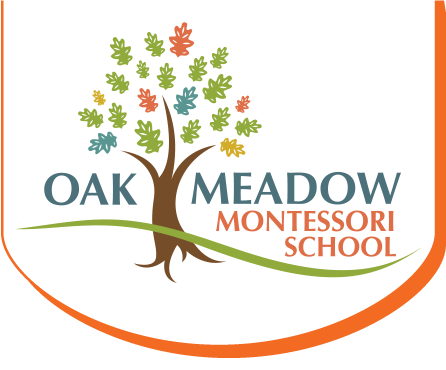Imagine a classroom where students have the freedom to focus on work that is carefully matched to their own ability. That’s what happens every day at Oak Meadow, and I saw a clear example of this when I recently visited Jen Scalese’s upper elementary classroom to observe students working on math.
 At Oak Meadow, the teacher does not stand at the front of the room and present the same lesson to all of the students–sadly, a practice that is all too common in most schools. Instead, our teachers differentiate the curriculum based on the student’s ability. Using carefully prepared materials, lessons are taught to small groups of students who are working at mastering the same skills. The teacher spends considerable time observing students and assessing their progress and areas for growth. As students demonstrate mastery of the knowledge and skill required, they are able to advance to the next level of sophistication and complexity.
At Oak Meadow, the teacher does not stand at the front of the room and present the same lesson to all of the students–sadly, a practice that is all too common in most schools. Instead, our teachers differentiate the curriculum based on the student’s ability. Using carefully prepared materials, lessons are taught to small groups of students who are working at mastering the same skills. The teacher spends considerable time observing students and assessing their progress and areas for growth. As students demonstrate mastery of the knowledge and skill required, they are able to advance to the next level of sophistication and complexity.
When I arrived at the classroom, the teacher was sitting on the floor with a small group of students working on long division. The students were using a material called “racks and tubes,” which is designed to help students learn how to divide large numbers. The teacher walked through a simple example, dividing 9,411 (the dividend) by 3 (the divisor) to come up with 3,137 (the quotient). The material makes all of this learning very concrete. And once the teacher explained this, she stepped back and let the students work as a group to solve several other increasingly complicated division problems (potentially into the millions), including problems that cannot be divided evenly and are left with a remainder value. Students wrote out the problems on paper as well, reinforcing their understanding of how the concrete is expressed in the abstract language of math. What really struck me the most as I watched all of this was the level of concentration on the faces of all of the students, as well as the way they worked collaboratively to solve more difficult problems.
 As these students continued their work, the teacher moved to a second group of students working on different problems. This group was working on factoring, using a material called the pegboard. The teacher illustrated how to use the material to determine the factors of 12 ( which are 1, 2, 3, 4, 6, and 12). Students experimented to see if perhaps a factor had been missed. Would 5 be a factor? They tried it out and discovered that 5 does not work, something revealed through the material without the teacher needing to make the correction. Now that the students understood how the material worked, the teacher left them to work independently to derive the factors of four more numbers (18, 30, 24, and 35). Again, the students worked cooperatively, and I was struck by the fact that they were working in a purposeful way while having fun as well.
As these students continued their work, the teacher moved to a second group of students working on different problems. This group was working on factoring, using a material called the pegboard. The teacher illustrated how to use the material to determine the factors of 12 ( which are 1, 2, 3, 4, 6, and 12). Students experimented to see if perhaps a factor had been missed. Would 5 be a factor? They tried it out and discovered that 5 does not work, something revealed through the material without the teacher needing to make the correction. Now that the students understood how the material worked, the teacher left them to work independently to derive the factors of four more numbers (18, 30, 24, and 35). Again, the students worked cooperatively, and I was struck by the fact that they were working in a purposeful way while having fun as well.
As these students continued, the teacher moved to a third group of students, which was now working more abstractly, using a diagram on the white board to help them with prime factorization and exponents. With the teacher’s guidance, the students explored the factors of 288, as well as identifying which factors are prime. Based on a careful and methodical process, the students were able to determine that 288=25x 32. Leaving the students to work on their own, the teacher circled back to check on the other two groups. The classroom teaching assistant, Ethan Dauphinais, was also circulating throughout the room, available to assist if needed.
 It is intentional that students at Oak Meadow are able to work at their own skill level. The multi-age classroom is also an advantage; students benefit from observing students who are slightly ahead of them, or mentoring students who are still working to master a skill. Both of these are really important differentiators. Research shows unmistakably that students perform at higher levels, accept more challenging work, and stay more focused on task when they can progress at their own pace and benefit from peer collaboration.
It is intentional that students at Oak Meadow are able to work at their own skill level. The multi-age classroom is also an advantage; students benefit from observing students who are slightly ahead of them, or mentoring students who are still working to master a skill. Both of these are really important differentiators. Research shows unmistakably that students perform at higher levels, accept more challenging work, and stay more focused on task when they can progress at their own pace and benefit from peer collaboration.
There’s something deeper happening here as well. When I spoke with Mrs. Scalese after this class, she helped to highlight the deeper significance. “Honestly, being a Montessori teacher is a completely different experience than being a traditional teacher. At Oak Meadow, the teacher is a ‘guide’. The kids do all of the work. They learn by exploration, trial, error, and success. When we teach lessons, we are merely opening the door to a new concept. The child then takes the lesson and explores in-depth learning. This matters a great deal because students are directing their own learning. They can stick with a concept for a short amount of time or they can go in-depth and explore further, creating a deeper understanding. Students in traditional classrooms are dependent on the teacher to provide all of the knowledge, rather than learn by attempting, failing, trying again, and succeeding. This is not the case with children in a Montessori environment. The Montessori student learns to pursue the answers and find solutions to the problems.”





